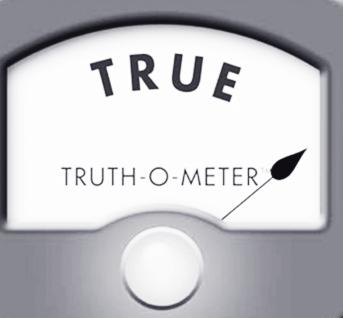消灭假新闻,就在现在!
2018-10-25ByWestonWilliams
By Weston Williams

Last year, Google implemented a new tool to fight the spread of misinformation on the web worldwide. The new “Fact Check” program automatically labels dubious stories in users search results, and provides links to fact-checking sites like Snopes and Politifact to establish the veracity of their claims.1
The new tool comes as major websites such as Google, Facebook, and Twitter continue to face pressure to check the spread of “fake news” across the internet, an issue which was catapulted2 into the spotlight during the US presidential campaign.
Over the past few years, sites such as Google have had to walk a fine line between policing false claims and supporting basic principles of free speech online. Google,after all, is the most popular search engine in the world, sporting more than 77 percent of the global search engine market share. And for many, that level of influence entails3 some responsibility to make sure its users are not misled.
“Building systems that help people get better at judging information is an important goal and helping people notice when information might not be credible is an excellent thing to do—in my work, I call this ‘designing for information assess ability,”says Andrea Forte, an assistant professor at Drexel Universitys College of Computing & Informatics in Philadelphia, Penn. “But depending on corporations to be responsible for educating people about credible information is not a reasonable solution.”
Dr. Forte said in an email that relying on ad revenue driven companies like Google is, at best, an“incomplete solution.” She adds that major websites depend on one-sided, positive messaging in order to make money, so even programs like Fact Check will never be an entirely reliable method of eliminating fake news and providing the user with fair, balanced information.

But its a start, she adds.
“Google was built to help people find useful information by surfacing the great content that publishers and sites create,” reads a blog post from Google explaining the new feature. “This access to high quality information is what drives people to use the web and for contributors to continue to engage and invest in it. However, with thousands of new articles published online every minute of every day, the amount of content confronting people online can be overwhelming.”
The new program was first tested in May, when Google gave publishers in certain countries the ability to show a Fact Check tag in Googles News section. The feature highlighted reputable articles that assessed the accuracy of statements by public figures.4
“For the first time, when you conduct a search on Google that returns an authoritative5 result containing fact checks for one or more public claims, you will see that information clearly on the search results page,” reads the Google blog. “The snippet6 will display information on the claim, who made the claim, and the fact check of that particular claim.”
A network of 115 fact-checking organizations will provide the accuracy assessment for dubious articles, rather than Google providing the fact-checking service itself. As a result, Google searches based on the same claim could return different takes on the storys accuracy or inaccuracy from different fact-checkers. But even with differing takes on a given storys accuracy, Google hopes that the range of opinions from different sources will give users an idea of the“degree of consensus” on any dubious claims.
Of course, some fake news readers will likely continue to reject the truth in favor of a fake news article that seems to support their pre-existing bias. But while Fact Check wont eliminate the problem of fake news completely, Forte thinks that Googles new tool is an important step in fighting the proliferation of misinformation on the web.
“Asking companies like Google and Facebook to think about these problems and do what they can to address them is a start, because designing to help people make good judgments should be a basic consideration in the design of all information systems,” says Forte. “But it doesnt go far enough. We need both technological and social solutions. Both good design and education.”
去年,谷歌發布了一款新的工具来阻止虚假信息在网络上传播。这个“事实核实”程序能够自动标记用户搜索结果中的可疑信息,还能向用户提供像“Snopes”和“Politifact”这样戳穿谣言的网站链接以验证其真实性。
谷歌、脸书以及推特等各大网站所面临的控制“假新闻”在网上传播的压力使得这款新工具应运而生。假新闻猖獗的情况在美国总统竞选期间引起了人们的关注。
在过去的几年里,像谷歌这样的网站不得不在监管假消息和维护网络言论自由的基本原则之间拿捏好分寸。它毕竟是世界上最受欢迎的搜索引擎,占据全球市场份额的77%以上。许多人认为,这种级别的影响力就需要谷歌承担起一定的责任,确保其用户不被误导。
“搭建能够帮助用户更好地甄别信息的系统是一个非常重要的目标,帮助人们识别出不可信的信息是一件非常棒的事情——在我的工作中,我把这称为‘信息评估能力设计,”宾夕法尼亚州费城的德雷塞尔大学计算机与信息学院的助理教授安德烈娅·福特说道,“但是只指望网络公司来教人们识别可靠信息并不是一个合理的解决方案。”
福特博士在邮件中说道,依靠谷歌这样靠广告收入驱动的公司解决这一问题,充其量也不过是个“不完善的解决方案”。她还说道,各大网络公司都是依靠片面的、积极的消息来赚钱,所以即便是像“事实核实”这样的程序也永远不会成为一个完全可以依赖的、消除假新闻的,并且能够为用户提供真实可靠的信息的途径。

但这是个开始,她补充道。
“谷歌的使命就是帮助用户通过浏览发布商和网站提供的优质内容进而找到有用的信息,”谷歌发布了一篇博文来解释这个新功能。“这种获取高质量信息的渠道是让用户继续使用这个网站、让股东继续参与并投资的动力。然而,每天每分钟有成千上万的新文章在网上发布,用户面对的内容数量是非常巨大的。”
这个新程序起初是在5月测试的,当时谷歌给几个国家的发布商开通了能够在谷歌新闻页面显示事实核查标签的功能。这项功能可以标记出已经检验过公众人物言论准确性的可靠文章。
“这是第一次当你用谷歌搜索出一个包含了对公共言论事实核查的权威性结果时,你可以在搜索结果页面很清楚地看到这一信息,”谷歌的博文写道,“旁边的一小段文字会提供那个公共言论的有关信息。包括言论的发布者以及这一言论的可靠性检验。”
由115个事实核查组织构成的系统将对可疑文章进行可靠性检查,而不是谷歌公司自己提供核查服务。所以,使用谷歌搜索所得到的信息可能会被不同的事实核查方得出不同的结论。但是即便这些结论是不同的,谷歌公司也希望这些不同来源的不同的观点能够让用户知道可疑信息的“共识程度”。
当然,一些用户可能会继续拒绝接受真相,而去相信能够支持其固有偏见的假新闻。不过,尽管事实核查程序无法完全消除假新闻,福特博士认为,谷歌的这个新工具在对抗虚假信息在网络上肆意传播方面仍然是非常关键的一步举措。
“要求谷歌和脸书这样的公司为假消息问题出谋划策并且尽其所能解决这些问题只是一个开始,因为帮助人们对信息进行正确的判断是所有的信息系统应该考虑的基本问题,”福特博士说道,“但是我们做得还远远不够。我们既需要科技层面的解決方案,也需要社会层面的。既需要好的设计,也需要好的教育。”
1. Snopes: 美国一家专门核查并揭穿谣言和传闻的网站;Politifact: 《坦帕湾时报》编辑委员会运营的一个博客,负责对国会议员、白宫、游说人士以及各利益集团的声明进行事实核实。
2. catapult: 突然把……捧出名。
3. entail: 需要,使……成为必需。
4. highlight: (在计算机上用不同颜色)突出显示,(用色笔)标出;reputable: 声望好的,值得信赖的。
5. authoritative: 权威性的。
6. snippet: 一小条信息。
